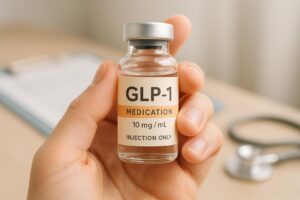The Risks of Overusing GLP-1 Medications for Weight Loss and Diabetes

Have you ever wondered about the potential consequences of taking too much of a medication designed to help with weight loss and diabetes management? With the rising popularity of GLP-1 receptor agonists like semaglutide (marketed as Ozempic® and Wegovy®), many individuals are turning to these medications under the guidance of healthcare providers. However, as the usage of these drugs increases, so do questions surrounding their safety, particularly regarding dosage and potential overdose. In this blog post, we aim to explore what happens if you take too much GLP-1, the signs to watch for, and how to manage any adverse effects effectively.
Introduction
The rise of obesity and its related health issues has led to an increased interest in effective weight-loss solutions. According to the CDC, the prevalence of obesity in the United States was 42.4% in 2017-2018, a significant increase from previous years. This has prompted healthcare providers to explore various treatment options, including GLP-1 receptor agonists, which are designed to mimic the effects of a natural hormone that regulates blood sugar and appetite. As more individuals turn to these medications, understanding the implications of dosage becomes crucial.
At TrimRx, our journey began with a vision to help individuals achieve healthier lifestyles through personalized, medically supervised weight loss solutions. We believe in the importance of transparent service and empathetic care, focusing on safety and individualized treatment plans. As we delve into this topic, you will learn about the symptoms and risks associated with overusing GLP-1 medications, the importance of adhering to prescribed dosages, and why personalized care is essential in managing weight loss effectively.
By the end of this blog post, readers will understand the potential consequences of excessive GLP-1 intake, recognize the signs of an overdose, and know how to seek help. We will also discuss the significance of having a personalized treatment plan, which is a core aspect of our offerings at TrimRx. Let’s navigate this critical conversation together.
Understanding GLP-1 Receptor Agonists
What Are GLP-1 Receptor Agonists?
GLP-1 receptor agonists are a class of medications that include semaglutide, liraglutide, and others. These drugs work by mimicking the effects of the glucagon-like peptide-1 hormone, which plays a significant role in regulating glucose metabolism and appetite. By activating GLP-1 receptors, these medications help lower blood sugar levels and promote weight loss by enhancing feelings of fullness.
Approved Uses of GLP-1 Medications
The FDA has approved several GLP-1 medications for managing type 2 diabetes and, more recently, for weight management. For example:
- Ozempic® (semaglutide): Primarily used for managing diabetes, it has also gained traction as a weight loss aid.
- Wegovy® (semaglutide): Specifically approved for weight management in adults with obesity or overweight conditions.
While these medications are effective tools in managing weight and blood sugar levels, understanding how to use them safely is paramount.
Why Dosage Matters
Dosage is a critical aspect of any medication regimen, especially for GLP-1 receptor agonists. Each individual may require a different dosage based on their specific health needs, weight loss goals, and response to treatment. At TrimRx, we emphasize the importance of starting with a lower dosage and gradually increasing it under medical supervision to mitigate potential side effects. This “step-up approach” is essential for allowing the body to adjust while minimizing adverse reactions.
Consequences of Taking Too Much GLP-1
Signs of Overdose
Taking too much GLP-1 can lead to several symptoms, many of which are gastrointestinal in nature. Common signs of an overdose include:
- Severe Nausea and Vomiting: These are the most frequently reported side effects, often escalating in intensity with increased dosages.
- Abdominal Pain: Patients may experience significant discomfort or pain in the abdomen.
- Diarrhea: Increased bowel movements can occur, often leading to dehydration if not managed properly.
- Headache and Dizziness: These symptoms may be exacerbated by dehydration due to vomiting or diarrhea.
According to reports from poison control centers, the incidence of calls related to GLP-1 overdose has dramatically risen in recent years, highlighting a growing concern as more individuals use these medications.
Serious Complications
In severe cases, excessive dosages of GLP-1 medications can lead to life-threatening complications such as:
- Severe Dehydration: Continuous vomiting and diarrhea can result in dehydration, which may necessitate hospitalization.
- Hypoglycemia: Although rare, low blood sugar can occur, especially in individuals taking other diabetes medications.
- Acute Pancreatitis: Inflammation of the pancreas can arise from excessive GLP-1 use, requiring immediate medical attention.
Recognizing these symptoms early is crucial, as some may require urgent care. If you or someone you know experiences severe symptoms, it is vital to seek medical assistance immediately.
The Role of Compounded Medications
With the increasing demand for GLP-1 medications, some individuals have turned to compounded versions, which are not FDA-approved. Compounded medications can pose significant risks, as their efficacy and safety are not guaranteed. Reports indicate that overdoses are more likely to occur with compounded versions due to improper dosing and lack of standardized formulations. At TrimRx, we prioritize safety by working exclusively with FDA-registered pharmacies to provide medications that adhere to the highest standards.
Preventing Overdose
Proper Dosage Education
Education on how to administer GLP-1 medications correctly is vital to preventing overdose. Patients should receive clear instructions from their healthcare providers regarding the appropriate dosage and administration techniques. This includes understanding how to measure doses accurately, especially when using syringes.
Regular Monitoring
Regular check-ins with a healthcare provider are essential for anyone on GLP-1 therapy. Monitoring progress allows for timely adjustments to the treatment plan, ensuring that patients are receiving the most effective and safe dosages for their needs.
Utilizing Technology
At TrimRx, we leverage advanced telehealth innovations to provide personalized care. Our platform allows for continuous support and communication with healthcare professionals, ensuring that patients can easily access guidance and assistance throughout their weight loss journey. We encourage readers to take our free assessment quiz to determine eligibility for personalized weight loss medications. Take the quiz here.
When to Seek Help
Contacting Poison Control
If you suspect an overdose, it is crucial to act quickly. The national poison control hotline (1-800-222-1222) is available for immediate assistance and provides expert guidance on how to proceed based on the specific situation.
Emergency Assistance
In cases of severe symptoms, such as loss of consciousness or difficulty breathing, emergency medical care should be sought immediately. Do not hesitate to call 911 if you or someone else is in a life-threatening situation.
Conclusion
Understanding the implications of taking too much GLP-1 medication is essential for anyone considering or currently using these treatments. While GLP-1 receptor agonists can provide significant benefits for weight loss and diabetes management, it is crucial to adhere to prescribed dosages and monitor for any adverse effects actively.
At TrimRx, we are dedicated to supporting individuals on their weight loss journeys through personalized, medically supervised care that prioritizes safety and efficacy. If you are interested in exploring personalized weight loss solutions, we invite you to take our free assessment quiz. Start your journey today.
Your health and well-being are our top priorities. Together, we can navigate the complexities of weight loss and find the solutions that work best for you.
FAQ
What should I do if I think I have taken too much GLP-1 medication?
If you suspect an overdose, contact poison control immediately at 1-800-222-1222 or seek emergency medical attention.
What are the common side effects of GLP-1 medications?
Common side effects include nausea, vomiting, diarrhea, abdominal pain, and headaches. If these symptoms escalate, it is important to consult a healthcare provider.
How can I ensure I am taking the correct dosage?
Always follow your healthcare provider’s instructions, and consider utilizing a medication management service like TrimRx for personalized support.
Are compounded GLP-1 medications safe?
Compounded medications are not FDA-approved and may carry additional risks. It is advisable to use FDA-approved formulations whenever possible.
How can TrimRx assist me in my weight loss journey?
TrimRx offers personalized weight loss solutions, including access to FDA-registered pharmacies, ongoing support, and tailored treatment plans. Take our free assessment quiz to find out more about your options.

Transforming Lives, One Step at a Time
Keep reading
Tracking Progress With GLP-1: What To Measure
Learn which metrics to track on GLP‑1 therapy—weight, waist, blood sugar, lipids, side effects, and non‑scale wins—and how often to monitor them.
Fatigue Solutions for Ozempic and Wegovy Users
Hydration, protein-rich meals, light activity, and better sleep can reduce medication-related fatigue and help maintain energy during weight-loss treatment.
GLP-1 Medication Side Effect Checker
Worried about GLP-1 medication side effects? Use our free checker for Semaglutide, Liraglutide, and more to learn what to expect and stay informed!



